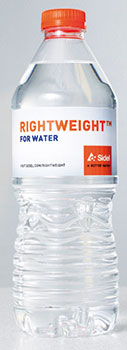Sustainable PET packaging for liquids
Sidel*, a company that interprets the theme of sustainability holistically, contributes with a critical look at how packaging is designed and distributed, and the effect on purchasing trends and the development of PET containers.
* Nicholas Bloch (Executive Vice President, Communications, Sidel)
 Manufacturer of complete lines for the packaging in PET (from blow moulding to packaging to palletizing), Sidel aims to improve productivity and optimize overall running costs, while mindful of the environment. Hence for Sidel the importance of adopting a holistic view of the entire supply chain, considering the impact of packaging at every stage: from the raw materials to the consumer, to recycling. In terms of sustainability, a variety of factors must therefore be considered:
Manufacturer of complete lines for the packaging in PET (from blow moulding to packaging to palletizing), Sidel aims to improve productivity and optimize overall running costs, while mindful of the environment. Hence for Sidel the importance of adopting a holistic view of the entire supply chain, considering the impact of packaging at every stage: from the raw materials to the consumer, to recycling. In terms of sustainability, a variety of factors must therefore be considered:
- reducing the environmental footprint of containers due to lower consumption of raw materials and other resources;
- reducing energy consumption or use of renewable energy sources, especially during production and transportation;
- adoption of the principles for the proper disposal of containers right from the planning stages;
- use of recycled materials to produce new containers;
- the adoption of a series of measures for the management of containers at the end of life (recycling).
Transport. Product transportation is crucial, especially if long distances are involved. In this sense, the lightening of containers was immediately accepted as a challenge by the beverage packaging industry, because of the smaller amount of raw materials used and, consequently, the potential for reduced costs and reduced environmental impact.
 Lighter materials. Lightweighting rightly continues to be a priority for the beverage industry, where the amount of raw materials needed to produce the PET bottles are already reduced in the design stage. A two-litre PET bottle in1980 weighed 68 grams today it weighs only 42, while the average weight of a single-serve half litre PET mineral water bottle is down to 9.9 grams, almost half of what it weighed in 2001.
Lighter materials. Lightweighting rightly continues to be a priority for the beverage industry, where the amount of raw materials needed to produce the PET bottles are already reduced in the design stage. A two-litre PET bottle in1980 weighed 68 grams today it weighs only 42, while the average weight of a single-serve half litre PET mineral water bottle is down to 9.9 grams, almost half of what it weighed in 2001.
Purchasing trends. Consumers are more than ever aware of the impact of packaging.
Moreover, like retailers, they want to know the origin and methods of production of the beverages.
They are attentive to recycling and prefer the use of recycled materials, among other things appreciating the indication on the label of the recycled materials used.
The new frontiers of PET. PET is a lightweight, safe and durable packaging material and its production requires much less power consumption compared to other materials.Furthermore PET is 100% recyclable.
Research is focusing on the possibility of making PET bottles using the by-products of organic agriculture. The new material is called Bio-PET and can also be matched to PET and R-PET (recycled PET) to obtain a mixture of PET, further expanding the opportunities for recycling.
|
A BETTER MATCH Sidel (Tetra Laval Group) is a leading provider of production equipment and services for liquids in PET, can and glass. Sidel is responsible for helping to package beverages enjoyed by millions of consumers around the world every day. With 30,000 machines installed in more than 190 nations, Sidel has been helping food and beverage producers for over 100 of its 165 years of existence. They have been helping producers fill beverage bottles for over 80 years and blow them for more than 50. Sidel has 40 years of aseptic packaging expertise and it hase been the first companies to introduce PET bottles to the beverage industry over 35 years ago. |




















